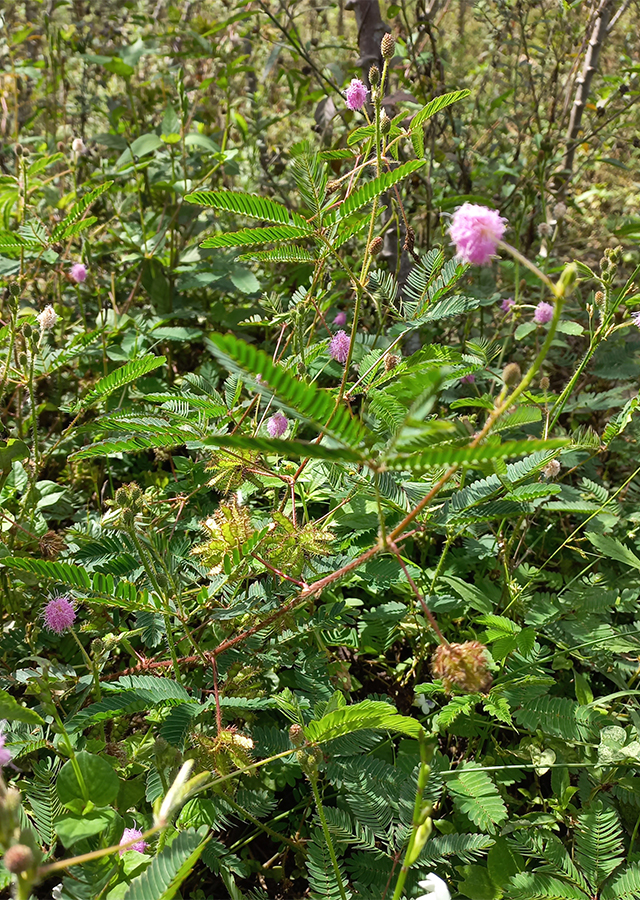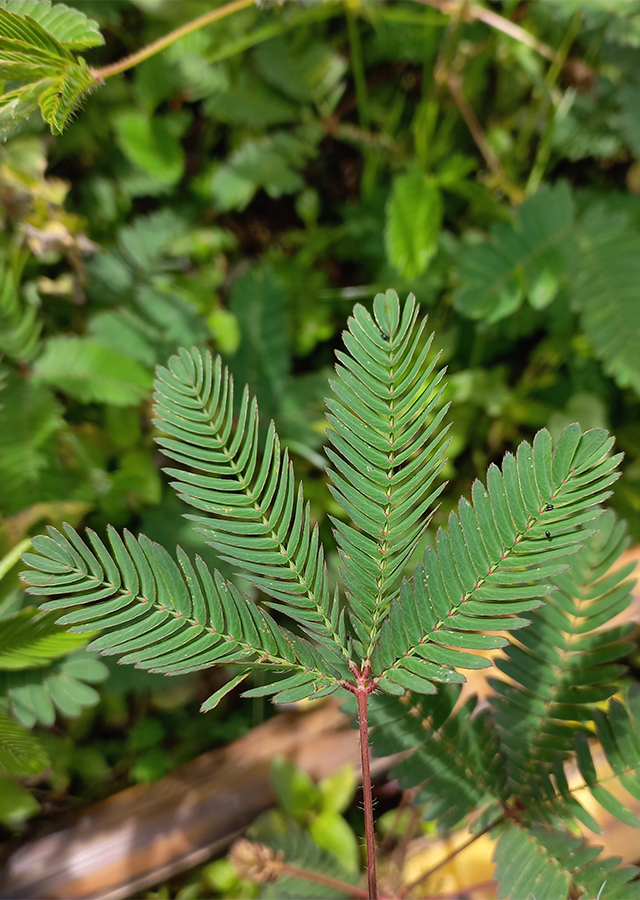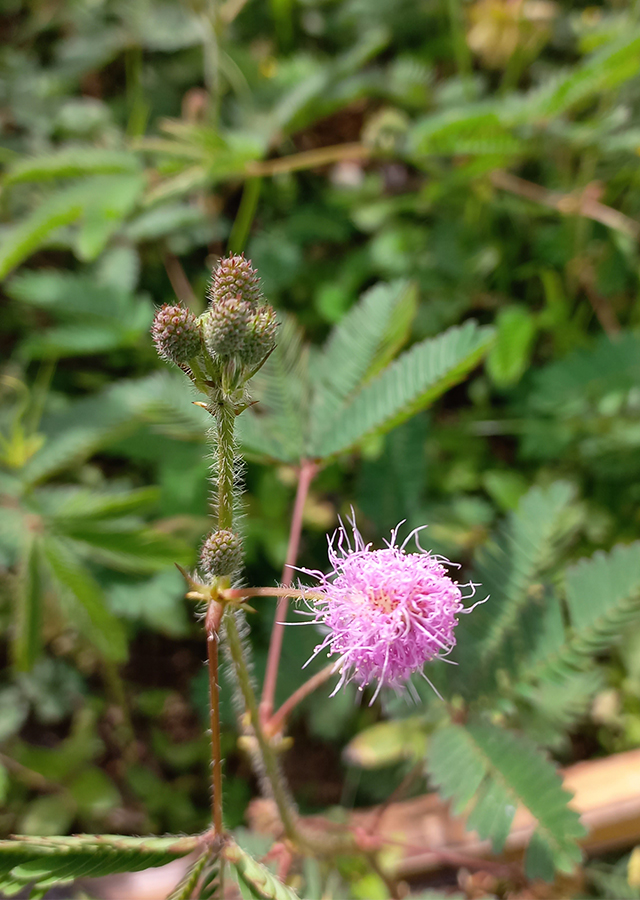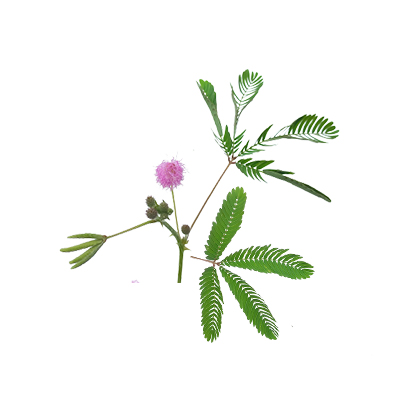Sensitive Plant
Mimosa pudica L.
Fabaceae
Location in our garden
Principal



Synonym
Eburnax pudica (L.) Raf.
Habitus
Herbaceous. An annual or perennial herb, sometimes woody at base and then subshrubby, up to 1-1.5 m tall
Part Used
Leaves
Roots
Stem
The Whole Plant
Growing Requirements
Full Sunshine
Drought Resistant
Habitat
Riverbanks
Forest
Coastal
Roadside
Grassland
Terrestrial
Overview
M. pudica is of tropical American origin, native from southern Mexico to mid-South America and the Caribbean. It is likely that the species has been introduced to some of the extreme parts of the New World range. The plant is harvested in small amounts for personal use, and is only very rarely traded. This species is typically present in disturbed areas in much of the tropics where it has naturalized.
Vernacular Names
Semalu (Malay), Babain (Philippines), Mai yarap (Thai), Dedinnaru (Sri Lanka), Mäc cö (Vietnamese), Pa chou cao (Chinese), Ojigiso (Japanese), Erba casta (Italian), Honteuse mâle (French), Dormidera (Spanish), Sinnpflanze (German).
Agroecology
Sensitive plant is common in wasteland, disturbed areas and overgrazed sites with moderately to poorly fertile soils. It occurs in the humid tropics and tolerates waterlogging but is not well adapted to the seasonally dry tropics. In the Malesian region, sensitive plant is found up to 1000 m altitude. It is regarded as a weed in upland field crops, in rainfed wetland rice and in plantation crops where it is reasonably tolerant of shade. It occurs over a wide range of soils, but iron chlorosis has been noted on coralline soils with a high pH.
Morphology
- Stems - usually sparsely armed with recurved prickles up to 5 mm long, glabrous to densely hispid.
- Leaves - alternate, bipinnate, unarmed, sensitive; petiole (1.5-)3-5.5 cm long, hispid, rachis very short, giving the two pairs of pinnae a subdigitate position; stipules caducous; leaflets 10-26 pairs per pinna, oblong to subfalcate, 0.6-1.5 cm × 0.1-0.3 cm, margins setulose.
- Flowers - bisexual, 4-merous, sessile, lilac, pink or blue-purple; calyx inconspicuous, about 0.1 mm long; corolla narrowly campanulate, 2-2.5 mm long, with obtuse to rounded lobes; stamens free, much longer than corolla; ovary superior, glabrous, style long and slender.
- Fruits - flattened oblong pod, 1-1.8 cm × 0.3-0.5 cm, several together in a cluster, densely setose, prickly on margins, consisting of 3-5 1-seeded joints which break away from the persistent sutures.
- Seeds - suborbicular to broadly ellipsoidal, flattened, 2.5-3 mm long, pale brown, surface finely granular.
Cultivation
Propagated by seeds.
Chemical Constituents
Alkaloid, mimosine, a non-protein alpha-amino acid, flavonoids, phytosterol, tannins, glycoside, fatty acids, cardiac glycosides, coumarin glycosides, saponins, phenols and terpenoids.
Traditional Medicinal Uses
- Studies have suggested antibacterial, antivenom, antifertility, antidepressant, anticonvulsant, aphrodisiac, antimalarial, hepatoprotective, hypolipidemic, hypoglycemic, antinociceptive, nerve regenerative, antimenorrhagic, adaptogenic properties.
- Entire plant in decoction used as alterant and antiasthmatic.
- Root considered aphrodisiac, and used for bladder gravel and similar urinary complaints.
- Powdered roots and leaves taken with milk for piles and fistula.
- Decoction or infusion of leaves used in asthma; expectorant. Used for hypertension, menorrhagia, glandular swelling, sore throat and hoarseness.
- Powdered seeds applied to wounds and sores.
- Bruised leaves applied to bruises.
Part Used
Reference Sources
- StuartXchange. Philippines Medicinal Plant. (2020). Mimosa pudica. http://www.stuartxchange.com/Makahiya.html. 14-10-21.
- Plant Resources of South East Asia. (2016). Mimosa pudica. https://uses.plantnet-project.org/en/Mimosa_pudica_(PROSEA). 14-10-21.
- Cabi. (2021). Mimosa pudica. https://www.cabi.org/isc/datasheet/34202. 14-10-21.



